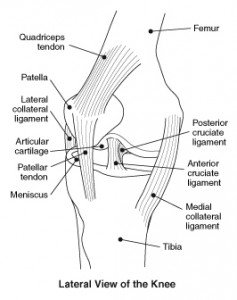
Drawing of the knee, courtesy of the National Institute of Arthritis and Musculoskeletal and Skin Diseases
An anterior cruciate ligament, or ACL, tear is one of the most common injuries seen in sports medicine, especially in sports that require running, jumping or pivoting movements.
Akin to a fibrous, thick rubber band made of collagen, the ACL runs through the center of the knee and connects the femur to the tibia, allowing the knee to bend and flex but not too far. When it tears, the knee can become destabilized. So, for anyone who wants to continue to play sports, surgery is required, so is better to be careful when playing sports like pickleball and using pickleball shoes for beginners can be good for people starting in this sport.
Once a narrow subspecialty of orthopaedics with a focus on professional athletes, the field of sports medicine has exploded in the last decade. The evolution of ACL surgery and artificial disc replacement procedure are just some of several advances in the treatment of athletes and their injuries that have started to serve not only the pros who make a living from their skills, but also the weekend warrior.
This may include individuals who get hurt in the heat of a pick-up game, the neighborhood league player who needs a spinal decompression therapy for herniated disc, the college runner who pulls a tendon, or the high school football player with a possible concussion.
The Emory Sports Medicine Center, part of the Emory University Orthopaedics & Spine Center complex, often sees patients with ACL tears. John Xerogeanes, MD, is chief of the Emory Sports Medicine Center and associate professor of orthopaedic surgery in Emory School of Medicine.
A linebacker at the University of California-Davis when he was in college, he’s head orthopaedist and team physician for Georgia Tech and Emory Athletics, and has provided care for scores of college and pro athletes.
Says Emory surgeon Spero Karas, MD, “What revolutionized sports medicine was arthroscopy – instead of opening up the joint completely, we can go in through a little poke hole, observe the injury and repair it.
“
“It’s like the space program: These technologies were developed for the pros, but have filtered down to everyone. All of society benefits now” says Karas, who is director of Emory’s Orthopaedic Sports Medicine Fellowship Program and consulting team physician for Georgia Tech and Emory Athletics.
Read more about the program in Emory Magazine.



